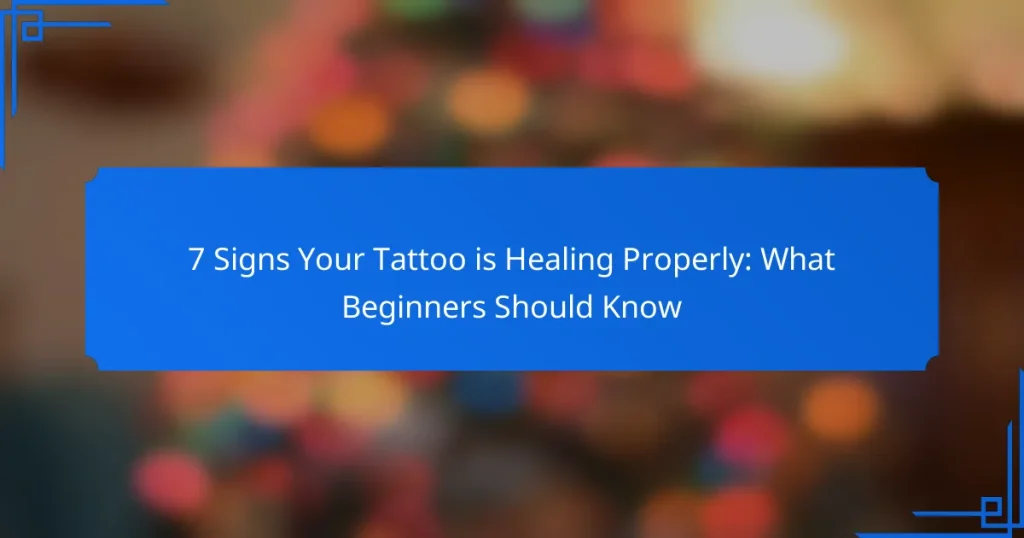Understanding the signs of proper tattoo healing is crucial for beginners to ensure their new ink remains vibrant and well-defined. Healing typically unfolds in two phases, with initial recovery taking about 2-3 weeks, while complete healing may extend up to 6 months. By recognizing the key indicators of healing, you can address any potential issues early and maintain the quality of your tattoo.
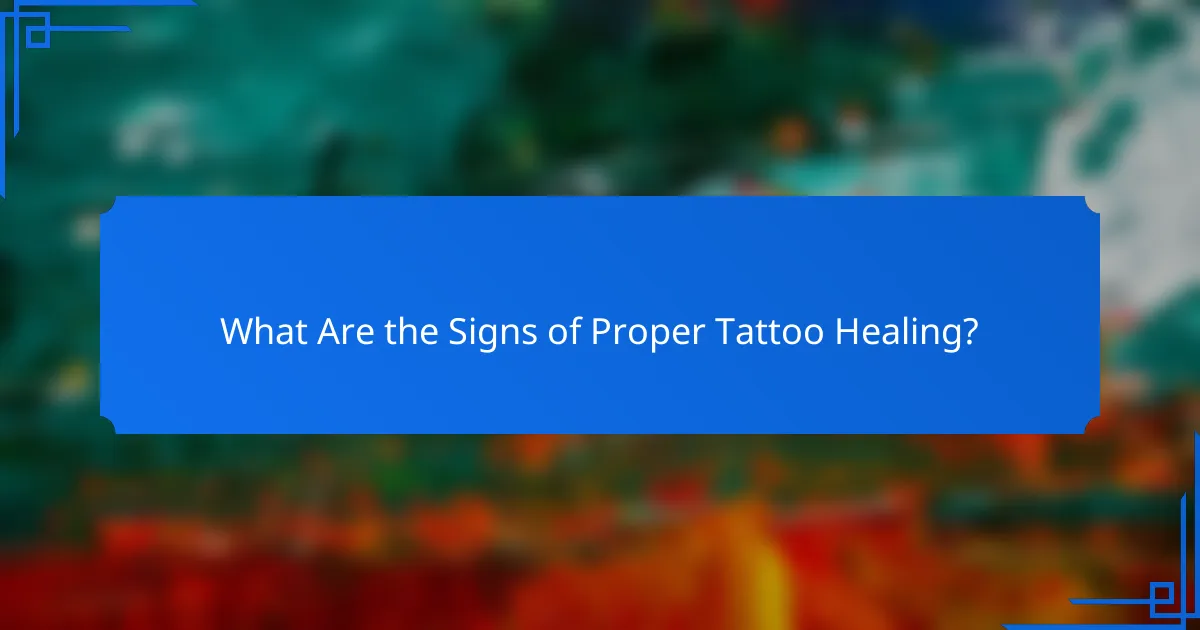
What Are the Signs of Proper Tattoo Healing?
Proper tattoo healing is indicated by several key signs that demonstrate your skin is recovering well. Recognizing these signs can help ensure that your tattoo maintains its quality and appearance over time.
Minimal redness
Minimal redness around your tattoo is a positive sign of healing. A little redness is normal immediately after getting inked, but it should gradually fade within a few days. If the redness persists or worsens, it may indicate an infection or other complications.
Decreased swelling
Swelling is common in the initial days following a tattoo session. As healing progresses, you should notice a significant reduction in swelling. If swelling continues beyond a week or is accompanied by pain, consult your tattoo artist or a healthcare professional.
Scabbing without excessive flaking
Some scabbing is typical as your skin heals, but it should not be excessive. Light scabbing indicates that your skin is repairing itself. Avoid picking at the scabs, as this can lead to scarring or color loss.
Itching sensation
An itching sensation is a common part of the healing process. It usually indicates that your skin is regenerating. To manage itching, keep the area moisturized with a recommended ointment and avoid scratching, which can damage the tattoo.
Color retention
Good color retention is a sign that your tattoo is healing properly. Initially, the colors may appear slightly dull, but they should become vibrant again as the skin heals. If you notice significant fading, it may be worth discussing with your tattoo artist to ensure proper aftercare was followed.

How Long Does Tattoo Healing Take?
Tattoo healing typically occurs in two main phases: initial healing and complete healing. The initial healing phase lasts around 2-3 weeks, while complete healing can take anywhere from 4 to 6 months, depending on various factors such as skin type and aftercare practices.
Initial healing: 2-3 weeks
During the initial healing phase, the outer layer of the skin begins to close over the tattoo. This period is crucial as the tattoo may appear vibrant but is still vulnerable to infection and damage. It’s essential to keep the area clean and moisturized to promote healing.
Common signs of proper initial healing include minimal redness, slight scabbing, and a reduction in swelling. Avoid picking at scabs, as this can lead to color loss or scarring.
Complete healing: 4-6 months
Complete healing involves the deeper layers of skin fully recovering, which can take several months. During this time, the tattoo may continue to settle and become more defined. It’s important to protect the tattoo from sun exposure and harsh chemicals to ensure optimal healing.
Indicators of complete healing include the absence of any discomfort, a consistent appearance of the tattoo, and no peeling or flaking. Regular moisturizing and sun protection can help maintain the tattoo’s quality long-term.

What Should You Do If Healing Signs Are Absent?
If you notice that healing signs are absent after getting a tattoo, it’s essential to take action promptly. This could indicate an underlying issue that needs professional attention to ensure your tattoo heals correctly and to prevent complications.
Consult your tattoo artist
Your first step should be to consult your tattoo artist. They can assess the tattoo site and determine if what you’re experiencing is normal or if there are signs of infection or other issues. Artists often have experience with various healing processes and can provide tailored advice based on your specific tattoo and skin type.
Bring any concerns to their attention, such as unusual redness, swelling, or lack of scabbing. They may recommend specific aftercare adjustments or suggest a follow-up appointment to monitor the healing process.
Visit a dermatologist
If your tattoo artist identifies potential problems or if you remain concerned, visiting a dermatologist is advisable. Dermatologists specialize in skin conditions and can diagnose any issues that may be affecting your tattoo’s healing. They can also provide treatments if there are signs of infection or allergic reactions.
When visiting the dermatologist, be prepared to discuss your tattoo’s aftercare routine and any symptoms you’ve experienced. This information will help them provide the best possible care and recommendations for your situation.
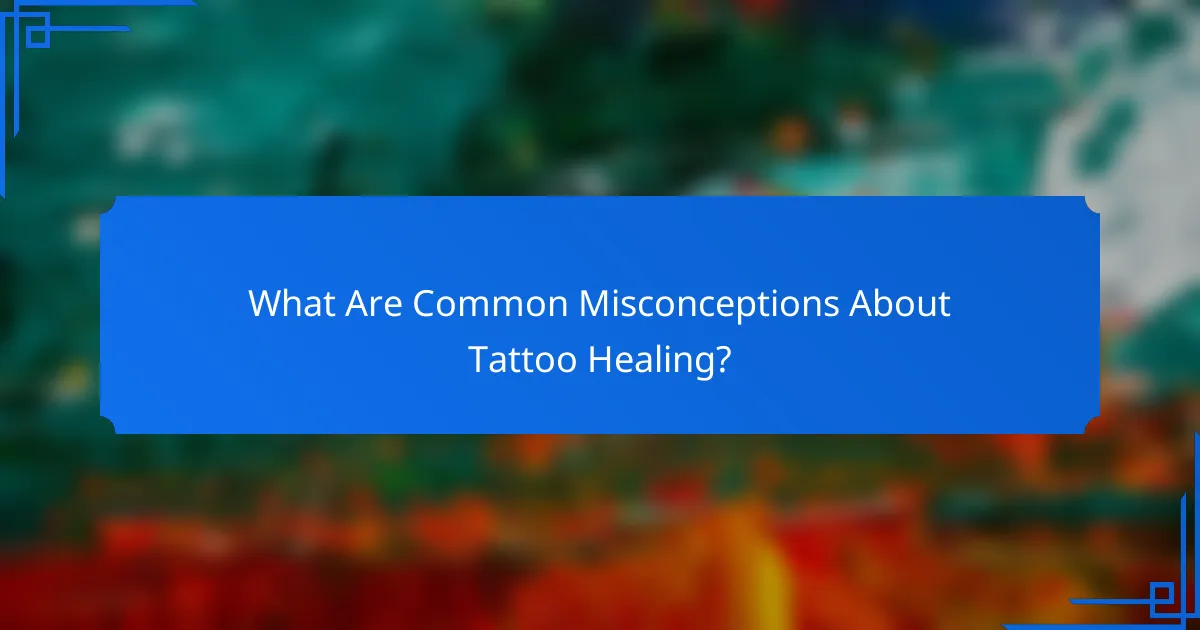
What Are Common Misconceptions About Tattoo Healing?
Many people hold misconceptions about tattoo healing, which can lead to improper care and complications. Understanding these myths is crucial for ensuring your tattoo heals correctly and looks its best.
All tattoos heal the same way
It’s a common belief that all tattoos undergo the same healing process, but this is not true. Factors such as the tattoo’s size, location on the body, and the individual’s skin type can significantly affect healing time and appearance. For instance, larger tattoos may take longer to heal compared to smaller ones, and tattoos on areas with more movement might experience different healing challenges.
Additionally, the technique and ink used by the tattoo artist can influence how well the tattoo heals. Some inks may cause more irritation or require different aftercare than others. It’s essential to follow your artist’s specific aftercare instructions to ensure proper healing.
Scabs must be removed
Many believe that scabs should be removed during the healing process, but this is a misconception that can lead to damage. Scabs form as a natural part of healing, protecting the tattooed area from infection and promoting skin regeneration. Removing scabs prematurely can result in color loss or scarring.
Instead of removing scabs, allow them to fall off naturally. To support this process, keep the tattoo moisturized and avoid picking at the scabs. If scabs are excessively large or painful, consult your tattoo artist or a dermatologist for advice on how to proceed safely.
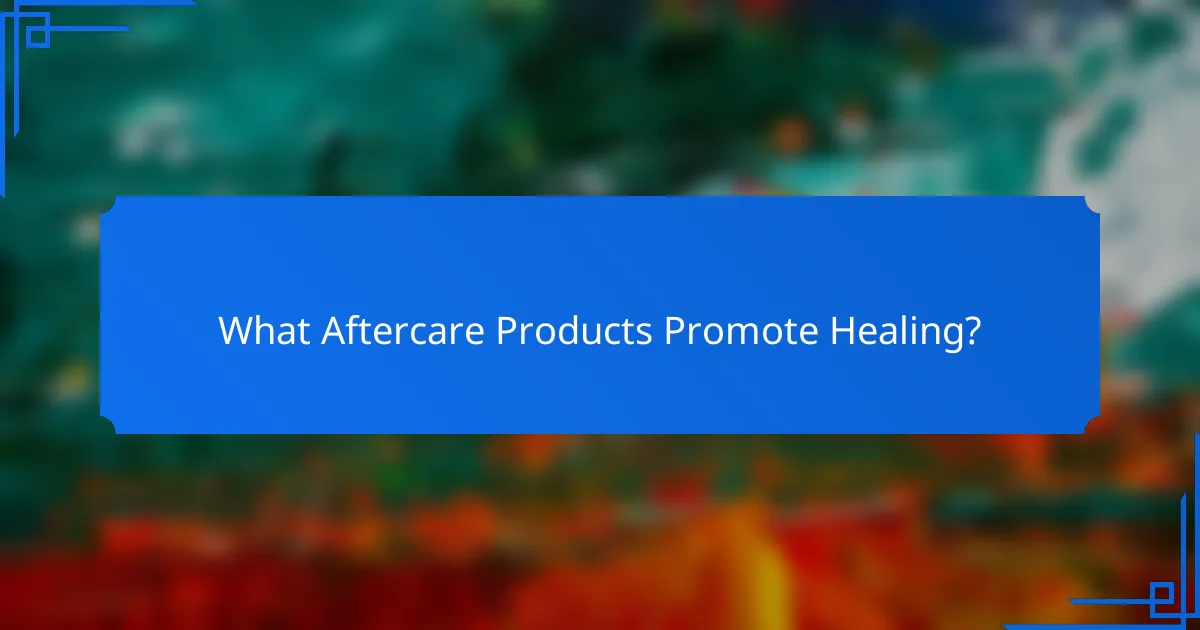
What Aftercare Products Promote Healing?
Aftercare products play a crucial role in ensuring your tattoo heals properly. Using the right products can help prevent infection, reduce irritation, and keep the skin moisturized, which is essential for optimal healing.
Fragrance-free lotion
Fragrance-free lotion is ideal for tattoo aftercare as it minimizes the risk of allergic reactions and irritation. Look for lotions that contain soothing ingredients like aloe vera or vitamin E, which can help hydrate the skin without overwhelming it with scents or chemicals.
Apply a thin layer of fragrance-free lotion to your tattoo several times a day, especially after washing it. This helps maintain moisture and supports the healing process, typically for the first two weeks post-tattoo.
Antibacterial ointment
Antibacterial ointment is important for preventing infection during the initial healing phase of your tattoo. Products containing ingredients like bacitracin or neomycin can provide a protective barrier against bacteria.
Use antibacterial ointment sparingly, applying a thin layer only for the first few days after getting your tattoo. Avoid overuse, as excessive application can clog pores and hinder healing.
Moisturizing balm
Moisturizing balm is beneficial for keeping the tattooed area hydrated and preventing scabbing. Look for balms that are specifically formulated for tattoo care, as they often contain natural ingredients that promote healing.
Apply the moisturizing balm as needed, especially if the tattoo feels dry or tight. This can be particularly helpful in the weeks following the tattoo session, ensuring the skin remains supple and healthy.
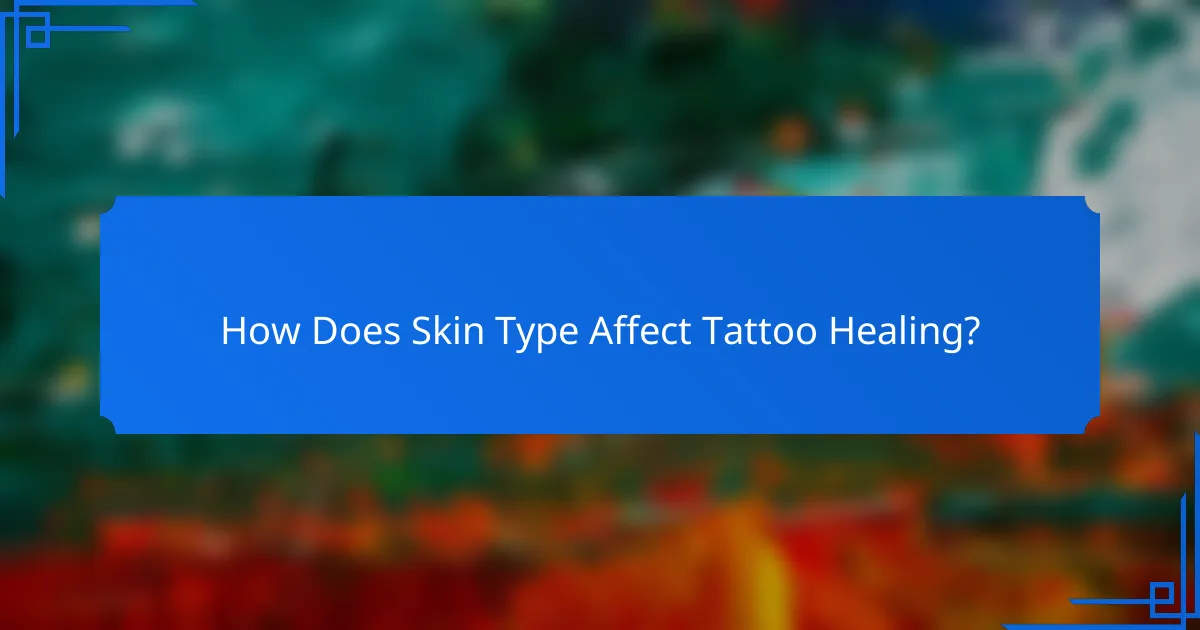
How Does Skin Type Affect Tattoo Healing?
Skin type plays a significant role in how tattoos heal, influencing factors like moisture retention, sensitivity, and overall recovery time. Oily skin may promote faster healing due to its natural moisture, while dry skin can lead to scabbing and prolonged healing. Understanding your skin type helps in selecting the right aftercare products and techniques.
Oily skin vs. dry skin
Oily skin tends to heal tattoos more quickly because the excess sebum provides natural moisture, reducing the likelihood of excessive dryness and scabbing. However, it can also lead to complications like ink blurring if not properly managed. Regular cleansing and using non-comedogenic products can help maintain balance during the healing process.
In contrast, dry skin may require more intensive care to ensure proper healing. Individuals with dry skin should consider using thicker, hydrating ointments to prevent cracking and scabbing. It’s essential to keep the tattoo moisturized without over-applying, which can lead to clogged pores.
Sensitive skin considerations
For those with sensitive skin, tattoo healing can be more challenging due to increased reactions to products and environmental factors. It’s crucial to choose hypoallergenic and fragrance-free aftercare products to minimize irritation. Patch testing any new product before full application can help identify potential reactions.
Additionally, sensitive skin may require a more gradual approach to tattoo care. Avoiding harsh scrubs or exfoliants during the healing process is advisable. Keeping the tattoo clean and moisturized while monitoring for any signs of adverse reactions will support a smoother healing experience.
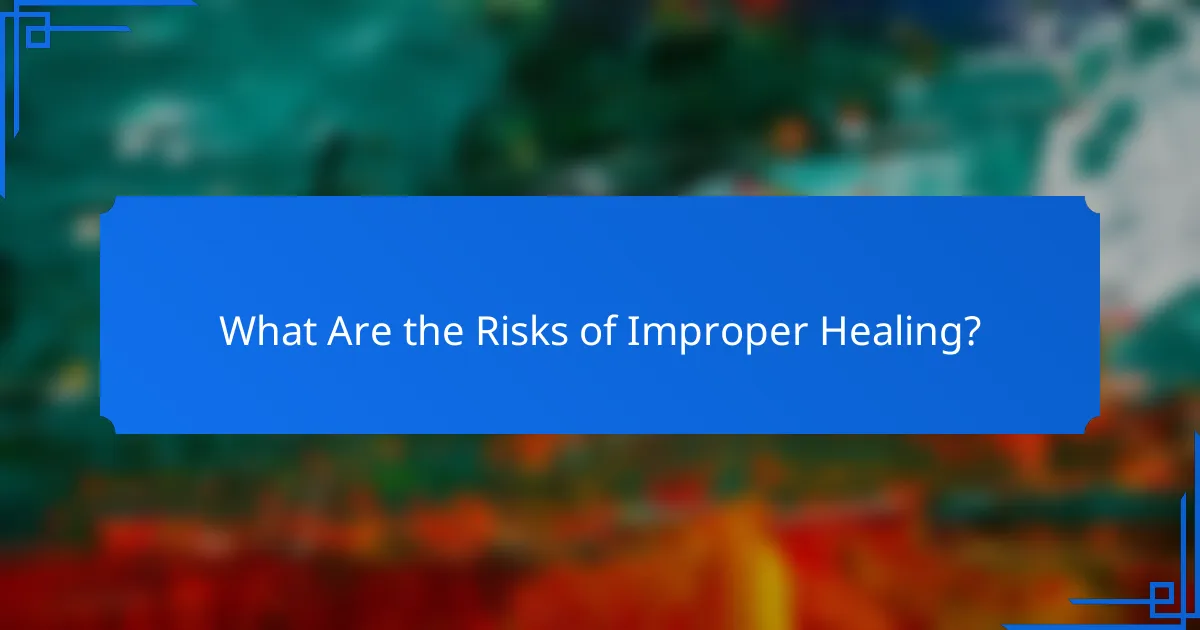
What Are the Risks of Improper Healing?
Improper healing of a tattoo can lead to various complications, including infections, scarring, and color fading. Understanding these risks helps ensure that your tattoo heals correctly and maintains its intended appearance.
Infections
Infections are one of the most serious risks associated with improper tattoo healing. Signs of infection include increased redness, swelling, pus, and persistent pain. If you notice any of these symptoms, it’s crucial to seek medical attention promptly to prevent further complications.
To minimize the risk of infection, keep your tattoo clean and dry. Use a mild soap and avoid soaking the tattoo in water, such as in baths or swimming pools, until it has fully healed.
Scarring
Scarring can occur if the tattoo is not cared for properly during the healing process. Picking at scabs or exposing the tattoo to excessive friction can lead to permanent marks on the skin. To avoid scarring, let any scabs fall off naturally and avoid tight clothing over the tattooed area.
If you are prone to scarring, consider consulting with your tattoo artist about aftercare products that can help minimize this risk. Silicone gel sheets or ointments may be beneficial in some cases.
Color Fading
Color fading can happen if the tattoo is exposed to sunlight or not properly moisturized during the healing phase. UV rays can break down the pigments in the ink, leading to a dull appearance. Always apply a high-SPF sunscreen once the tattoo has healed to protect its vibrancy.
Additionally, keeping the tattoo moisturized with a fragrance-free lotion can help maintain the ink’s color. Avoid using products with harsh chemicals that could irritate the skin.
Allergic Reactions
Some individuals may experience allergic reactions to tattoo ink, which can manifest as rashes or itching. If you have sensitive skin or a history of allergies, it’s advisable to perform a patch test before getting a tattoo.
Consult with your tattoo artist about the ingredients in the ink used. If you notice any adverse reactions during the healing process, contact a healthcare professional for guidance.
Delayed Healing
Delayed healing can occur due to various factors, including underlying health conditions, poor aftercare, or excessive physical activity. If your tattoo is taking longer than expected to heal, it may be a sign that something is wrong.
To promote faster healing, ensure you follow aftercare instructions closely, maintain a healthy diet, and avoid strenuous activities that could strain the tattooed area.
Granulomas
Granulomas are small bumps that can form around the tattoo site due to an inflammatory response. They are typically harmless but can be unsightly. If you notice these bumps, consult with a dermatologist for appropriate treatment options.
To reduce the risk of developing granulomas, avoid irritating the tattoo during the healing process and keep the area clean and moisturized.
